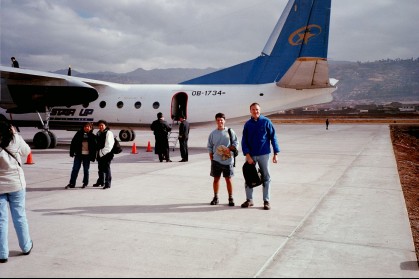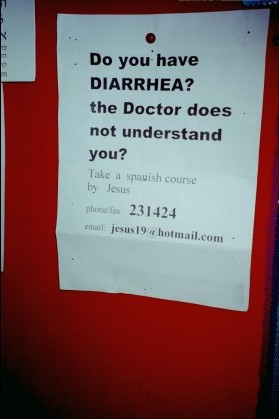
. . . LAND ROVER OVERLAND EXPEDITION
| VARIOUS: HOME |
| PERU |
| The
Inca Trail Aerquipa & El Misti Rio De Janeiro |
| ENGLAND |
| Walking
London A Country Drive |
OTHER EXPEDITIONS |
Africa
1999 |
VALUED SPONSOR |
Junglerunning Again Sitting
here in a row of backpackers, shoulder to shoulder, typing on sticky
keyboards, mindful of the escalating fees - seems like Africa was
just a few weeks ago. Excellent, Junglerunning again. Delays this
summer have been out of control, so our 30 minute wait on the runway
"to avoid thunderstorms in the south" felt like a reprieve.
Half an hour delayed into Miami, rushed through the terminal, ...pause
at the b/w photo displays... oh yeah, and rushed through the terminal
to the wide-body 767. Packed. Arrived in Lima at 4am. Not
purchasing the ticket to Cusco on Travelocity turned out to be a
shrewd move. The $200 fare in the States cost us $60 at the counter.
Flights left almost every 15 min, so we had no wait at all. Thanked
our tourist guide, paid the $4 departure tax, and boarded a Soviet
era turbo-prop (seemed like a rip-off of the DeHavilland Beaver).
Two hours and we were at altitude in Cusco. Located
in southern Peru, Cusco is the jumping off spot for the Machu Pichu
trek - South America�s premier hike. The town has evolved into a
tourist mecca; gobs of stores with handcrafted stuff (not enough
room in the backpack to buy as much as I'd like), restaurants ranging
from inexpensive good food to truly dirt-cheap local grub, and plenty
of cheap hostels. Touts are everywhere, "buy postcards",
"you go rafting, yes?", "very nice Italian food"...
Italian? Inca
History Pizzaro
entered the city a hero in 1533, looted Cusco�s temples, and installed
the puppet Inca Manco Capac II. When Manco realized that the Spanish
weren't leaving, he amassed an army of 150,000 and in 1563 attacked
the colonists. During his siege the Inca�s army set fire to the
city�s thatched roofs leaving Cusco in ruins. Manco�s subsequent
defeat at Sacsayhuaman sent him retreating into the jungle at Vilcabamba,
the last capital of a then-shrunken empire. In 1572, after a number
of costly attempts, the Spanish finally took Vilcabamba bringing
back the very last Inca, Tupac Amaru, whom they beheaded in the
Cusco Plaza de Armas, extinguishing the once-great Inca empire for
good. Acclimatization Hasta
luego, |
All rights reserved


